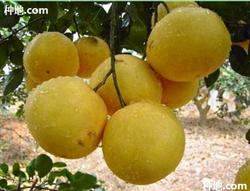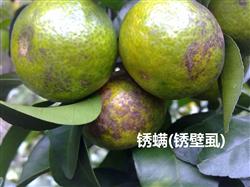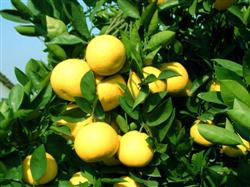Pictures of planting techniques and management methods of grapefruit (grapefruit)

Grapefruit has higher requirements for heat and is suitable for planting at an annual average temperature of 18 ° C or above. It can be planted in places with an annual accumulated temperature of more than 6000℃ above 10℃, and high-quality fruits can be produced above 7000℃. Lemon cold-resistant, resistant to extreme minimum temperature of-10℃ or so. Places where-8 ° C may occur cannot be planted. Therefore, planting in a suitable place or in a greenhouse can reduce the impact of temperature on its growth. Grapefruit in addition to strict temperature requirements, there are the following requirements: (1) soil: requirements are not strict, but the soil is loose, deep, fertile, neutral to slightly acidic soil is the most suitable;(2) rainfall: demand is not much, annual rainfall of more than 1000mm, whether the weather is wet or dry can be planted;(3) light: strong light and cloudy weather can grow better results. Grapefruit transplanting: Grapefruit planting period is winter low temperature period, planting from November to December, the second year grapefruit bud growth faster. Planting distance due to poor soil, fertile or different terrain, generally 7 meters ×7 meters or 7 meters ×8 meters is appropriate. When digging seedlings, it is best to bring soil balls or keep the roots moist. The planting hole shall be mixed with decomposed organic fertilizer 10~20 kg of superphosphate lime in advance, fully mixed evenly and solidly, and shall be slightly higher than the original ground after planting. Cover the area around the plant, irrigate, and shade the plant with a little straw to avoid defoliation and affect future growth. Grapefruit (grapefruit) fertilization method: Grapefruit planting in the first few years of small canopy, can be used to cover the ground under the canopy, in order to maintain soil nutrients, moisture, and increase soil organic matter, at the same time pay attention to the prevention and control of longicorn. After fruiting, it can be changed to grass cultivation or cover crop cultivation, mowing 2~3 times a year in summer, saving soil management costs, reducing soil erosion, and maintaining and increasing organic matter, so as to maintain good soil properties, reduce nutrient and water stress, and promote normal growth of trees. Fruit trees are fertilized twice a year. Base fertilizer is applied in December to January, and compound fertilizer (three elements are 15-15-15) is better, which is 60%~70% of the annual application rate, which promotes the flowering and flowering and the growth of spring shoots. Topdressing to promote fruit development, in May to June every year between the application, depending on the amount of fruit and increase or decrease, can be spread after rain when the soil wet. If the orchard soil is acidic, limestone powder or dolomite powder (both unburned) can be applied in autumn and winter, about 2 kg per tree to improve soil properties and improve fertilizer efficiency. In addition, irrigation should be carried out in dry season, and irrigation should be carried out once or twice every month to increase fruit bearing, improve fruit quality, and promote tree development. Grapefruit (grapefruit) pruning method: In order to facilitate the management and control of tree shape, grapefruit should adopt natural garden head pruning, trunk height 40~60 cm, and then leave 2~3 main branches, each main branch evenly leave 2~3 sub-main branches. Pay attention to the relativity of branch growth angle and direction when leaving main branch or sub-main branch. Young trees develop a good skeleton, which can reduce the trouble of pruning later. The pruning purpose of fruit trees is to adjust tree vigor, increase light and ventilation, cut off over-dense branches and diseased branches (especially canker branches and leaves), mechanically damage branches and weak branches. However, the pruning amount should not exceed 15% of the total number of branches and leaves. Pruning should be coordinated with fertilization and other soil management, such as excessive tree vigor, thinning of branches and reduction of nitrogen fertilizer application. If the tree vigor is weak, short pruning should be carried out, and more nitrogen fertilizer, organic fertilizer and irrigation should be applied to achieve the management goal. Grapefruit (grapefruit) pest control methods: 1. Toxin disease: It is the enemy of Taiwan citrus industry. It is transmitted by seedling scion and aphid, wood-borne insects, and can also be transmitted by mechanical cultivation management. Grapefruit plants are most susceptible to disease when nutrient and water stress is present, showing leaf yellowing. In autumn and winter, it presents symptoms of malnutrition and lack of trace elements. The fruit grows abnormally and asymmetrically, and the top part of the fruit does not turn color or does not turn color well. Grapefruit infected with toxin disease, can not be cured, prevention methods for the selection of non-infected seedlings planted in clean areas, strengthen field pest control, to avoid vector insect transmission, once found sick plants, dig and burn. Strengthen fertilizer management, make the plant strong, prolong the age, if the orchard infection rate reaches more than 10%, can not be planted again. 2, canker disease: symptoms such as citrus canker disease. The control method is as follows: cutting off diseased branches and leaves of seedlings, or cutting off diseased branches and burning diseased leaves in concentration during pruning, planting windbreak forest in orchards, also using areca nut to shade windbreak, reducing injuries, spraying 4-4 type Bordeaux mixture and other liquid medicines in rainy season. 3. Red and yellow spiders. Red spiders mainly harm leaves, seriously damaged leaves lose luster, was gray, causing deciduous, withered shoots. Yellow spider damage distorts leaves and causes deciduous shoots. The peak period of hazard is from mid-April to mid-June, and September is the second peak. Control methods: 1. Clear the garden in winter and spray the whole garden with 800 times solution of new lipid membrane. 4.. Harm symptoms: larvae harm young leaves, young fruits, flower buds, larvae often spin silk to young fruits and young leaves together, drill into the fruit to feed, so that young fruits turn yellow and fall off. Control methods: 1, winter garden, remove winter larvae. 2. Chemical control, focusing on after flowering and larval insect population density, 1-2 times of medication. 3. Pesticide selection: dichlorvos 5000 times solution;50% dichlorvos 800-1000 times solution; dichlorvos 800-1000 times solution; Jinsheng 1500 times solution combined with new lipid membrane 800 times solution. 5. Mianpian scale, red wax scale, arrow-tip scale. Harm symptoms: adults, larvae harm branches, leaves, fruits, and lead to the occurrence of soot disease, the victim tree growth weakness, branch wither, heavy death. Control methods: the key to control scale insects is to master the larval stage, spray concentrated before the adults form wax shells, the peak period of scale insects damage is from the end of March to the end of September, especially from the end of April to the middle of May. 500 times of new lipid membrane solution can be used in combination with 1000 times of solution to spray control. Click for more grapefruit growing techniques Click for more fruit growing techniques
- Prev

Sugar orange planting techniques: what are the diseases and insect pests of sugar orange in August?
What are the diseases and insect pests of sugar orange in August? Please introduce and guide the methods of prevention and control in August, which is from summer shoot growth to autumn shoot emergence, so there are more diseases and insect pests, the main pests are: rust mite, red wax scale, leaf moth, skin explosion, longicorn beetle; the main diseases are: canker, foot rot; detailed control methods.
- Next

Grapefruit (West Machine) harvesting method and how to store it?
Grapefruit (West Machine) harvesting method and how to store it? Please give a detailed introduction to grapefruit harvest can refer to the following methods: grapefruit harvest can be based on fruit maturity to determine the appropriate harvest time. Grapefruit harvest time is large due to the difference of climatic conditions in different cultivation areas, especially the difference of air temperature.
Related
- Moge, come on! The staff of the peasant association in the producing area of cantaloupe were frightened when the crowd gathered.
- Causes and Solutions of low Fruit setting rate of Apple
- Symptoms and control measures of passion fruit virus disease
- Fruit growing lesson: how do apple orchards keep high yields?
- Can you build orchards in the mountains? What are the pros and cons?
- How to manage the coloring period of Crisson grape?
- This paper introduces the processing technology of two kinds of fig products.
- How much is a month for retired teachers in rural areas by 2020?
- How can strawberry planting increase sugar content? We should pay attention to management in many aspects.
- What are the cultivation techniques on how to improve the yield of golden fruit?

